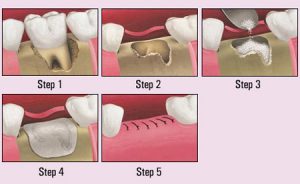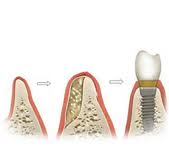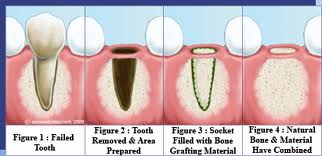Many times a dentist will need to increase the amount of bone in a patient’s jaw.
In cases where the jaw bone is damaged or receded, bone grafting is performed as a preparation step prior to a dental implant or restoration. These restorations require sufficient jaw bone volume for optimal chances of success.
Jaw bone volume can be insufficient for a number of reasons:
Periodontal (gum) disease and infections – progressively attacks gum tissue and will eventually damage the jaw bone if left untreated. Other infections can also diminish bone.
Tooth extraction – it is estimated that following a tooth extraction, the patient loses 40-60% of the bone surrounding the tooth site within three years.
 Injury – blows to the jaw or other dental injuries can cause the jaw to recede.
Injury – blows to the jaw or other dental injuries can cause the jaw to recede.
Recent developments in bone grafting techniques have made implant treatment possible in cases that would have been impossible just a few years ago. If increasing the amount of available bone is required for your case, it might add to the cost of treatment, require more time, introduce additional procedures and add to the risks involved.
There is more than one bone grafting technique, but they can be grouped into two types.
The first, and most extensive type of bone grafting is always done as a separate surgery from the implant placement. This types of graft is intended to make large changes to the shape and size of the dental ridge so that a stable implant can be placed, usually several months later. These procedures are generally performed by specialists such as oral surgeons or periodontists.
In the second type of bone grafting, the jaw may already have enough bone to place the implant, but not enough bone to completely cover the sides of the implant. These types of grafts are generally small in size and are performed at the time of implant placement.

Questions that you will wish to ask us about bone grafting are:
Will a bone graft be needed in my case?
Certainly the larger procedures can be predicted and planned well in advance; however, the smaller grafts done at the time of implant placement cannot always be predicted, and must be available to the surgeon in order to give your implant the best chance of success. It is vitally important that you and your dentist agree on this point before the start of the surgery.
Where does grafted bone come from?
Bone graft material comes from four general sources; your own available bone, freeze dried human bone from a tissue bank, processed bone elements from animals, and, finally, a mineral bone substitute.
Are all types of bone graft material equally effective?
The most effective graft material is your own natural bone, then freeze dried human bone, followed by processed animal bone, and lastly, mineral bone substitute.
Is bone grafting safe?
The safest, and most desirable source of bone grafting material comes from your own body. The act of drilling the jawbone for placing the implant naturally produces bone shavings. These shavings can be cleanly collected and used as grafting materials. In the cases of larger grafts, surgical procedures have been developed to harvest additional bone from other places in your body.
Also completely sterile, although the least effective, are mineral bone substitutes. You will be interested to know that the most popular mineral graft materials do not remain in the body, but are naturally absorbed by the body and replaced by healthy bone.

Consider receiving human donor bone or animal bone elements to be the same as receiving blood from the blood bank, with a similar level of risk. The processing techniques used to prepare the freeze dried bone and the animal bone elements results in graft materials which have proven to be extremely safe. Also, only materials from a reputable, well managed national tissue bank are used. There is, theoretically, an extremely small chance that infectious disease could be transmitted through either of these materials.
Be sure to discuss the possibility of bone grafting with your Lynn Valley dentist in North Vancouver and reach a firm understanding before the surgical procedure starts.
For more information on bone grafting, please see video below
